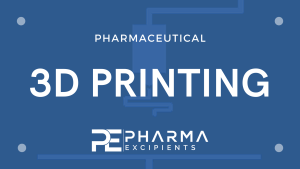Development of 3D-printed dual-release fixed-dose combination through double-melt extrusion

This study aimed to develop a 3D-printed fixed-dose combination tablet featuring differential release of two drugs using double-melt extrusion (DME). The hot-melt extrusion (HME) process was divided into two steps to manufacture a single filament containing the two drugs. In Step I, a sustained-release matrix of acetaminophen (AAP) was obtained through HME at 190 °C using Eudragit® S100, a pH-dependent polymer with a high glass transition temperature. In Step II, a filament containing both sustained-release AAP from Step I and solubilized ibuprofen (IBF) was fabricated via HME at 110 °C using a mixture of hydroxy propyl cellulose (HPC-LF) and Eudragit® EPO, whose glass transition temperatures make them suitable for use in a 3D printer. A filament manufactured using DME was used to produce a cylindrical 3D-printed fixed-dose combination tablet with a diameter and height of 9 mm.
To evaluate the release characteristics of the manufactured filament and 3D-printed tablet, dissolution tests were conducted for 10 h under simulated gastrointestinal tract conditions using the pH jump method with the United States Pharmacopeia apparatus II paddle method at 37 ± 0.5 °C and 50 rpm. Dissolution tests confirmed that both the sustained-release and solubilized forms of AAP and IBF within the filament and 3D-printed tablet exhibited distinct drug-release behaviors. The physicochemical properties of the filament and 3D-printed tablet were confirmed by thermogravimetric analysis, differential scanning calorimetry, powder X-ray diffraction, and Fourier-transform infrared spectroscopy.
HME transforms crystalline drugs into amorphous forms, demonstrating their physicochemical stability. Scanning electron microscopy and confocal laser scanning microscopy indicated the presence of sustained AAP granules within the filament, confirming that the drugs were independently separated within the filament and 3D-printed tablets. Finally, sustained-release AAP and solubilized IBF were independently incorporated into the filaments using DME technology. Therefore, a dual-release 3D-printed fixed-dose combination was prepared using the proposed filament.
Read more here
Materials
AAP was obtained from Hebei Jiheng (specification: EPEP/China) and IBF (specification: NF/ United States Pharmacopeia (USP)) was supplied by BASF (Ludwigshafen, Germany). The (meth)acrylate copolymers (Eudragit E PO, Eudragit E 100, and Eudragit S 100) were donated by EVONIK (Essen, Germany). The pharmaceutical excipients Hypromellose 2910 4.5 cps and Hypromellose 2208 1500SR, were obtained from Shinetsu (Tokyo, Japan). Klucel ™ ELF, LF, hydroxypropyl cellulose (HF), and Aqualon ™ N100 by Ashland.
Hye-Sung Oh, Jun-Bom Park, Development of 3D-printed dual-release fixed-dose combination through double-melt extrusion, International Journal of Pharmaceutics, 2024, 124407, ISSN 0378-5173, https://doi.org/10.1016/j.ijpharm.2024.124407.
Read also our introduction article on 3D Printing here:


